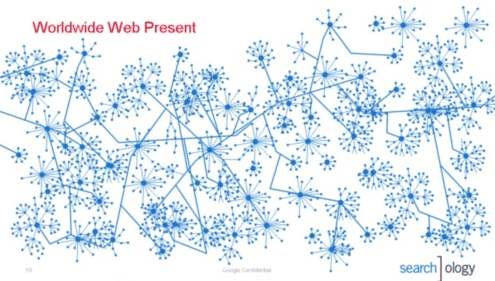At the
Searchology event, where Google talked about its history and launched some major new features, a slide caught my attention: this is the World Wide Web* today, or probably the most important sites and the links that connect them. Too bad we can't see the address for each node.
 * "The World Wide Web (or the Web) is a system of interlinked, hypertext documents that runs over the Internet. With a Web browser, a user views Web pages that may contain text, images, and other multimedia and navigates between them using hyperlinks." (Wikipedia)
* "The World Wide Web (or the Web) is a system of interlinked, hypertext documents that runs over the Internet. With a Web browser, a user views Web pages that may contain text, images, and other multimedia and navigates between them using hyperlinks." (Wikipedia)


Hmmm. I think those are physical nodes, not websites, but their topology is arranged in a non-geographical matter. You'll notice they are arranged sequentially (1 --> 2 --> 3), not hypertextually, which you would expect if this were a map of websites, but makes perfect sense if you're just following fiber optic lines connecting New York ---> London ---> Moscow.
ReplyDeleteThe WWW doesn't refer to the internet and I doubt that Google would make a mistake like that. As suggested, it's probably just the absolutely largest sites out there.
ReplyDeleteThey forgot to tell that at the center of the map there is Google itself
ReplyDelete[..]So sieht also laut Google das World Wide Web aus. Irgendwie voll klein und mikrisch wenn ihr mich fragt. Aber halt, das sollen ja auch nur die wichtigsten Internet Seiten des WWW sein.[..]
ReplyDeleteWikipedia posts a similar, mind blowing pic here, with IP addressess
ReplyDeletehttp://en.wikipedia.org/wiki/Image:Internet_map_1024.jpg
Hyperlinks are directional. So what do undirected edges in the graph mean? And it is somewhat strange to see "highways" of long hyperlink chains. Are all the links in these highways pointing in the same direction? (In which case, PageRank propagates through the highways).
ReplyDelete